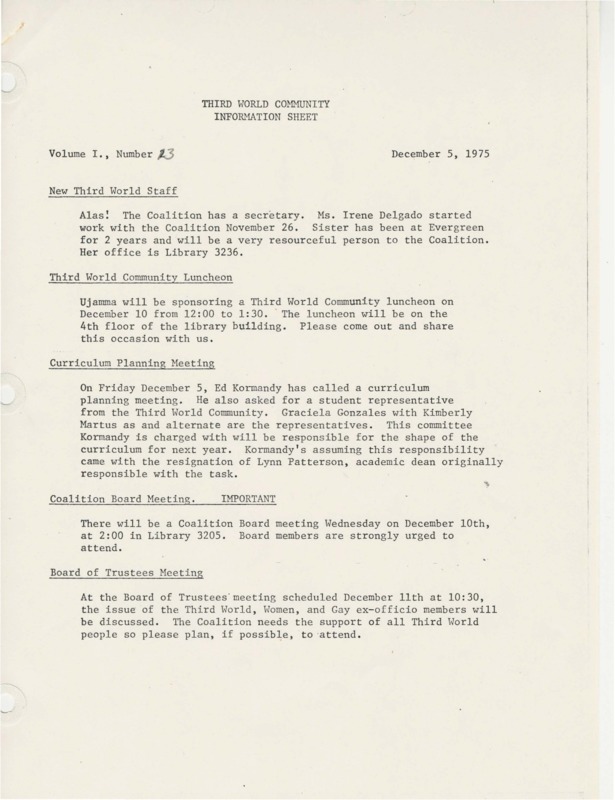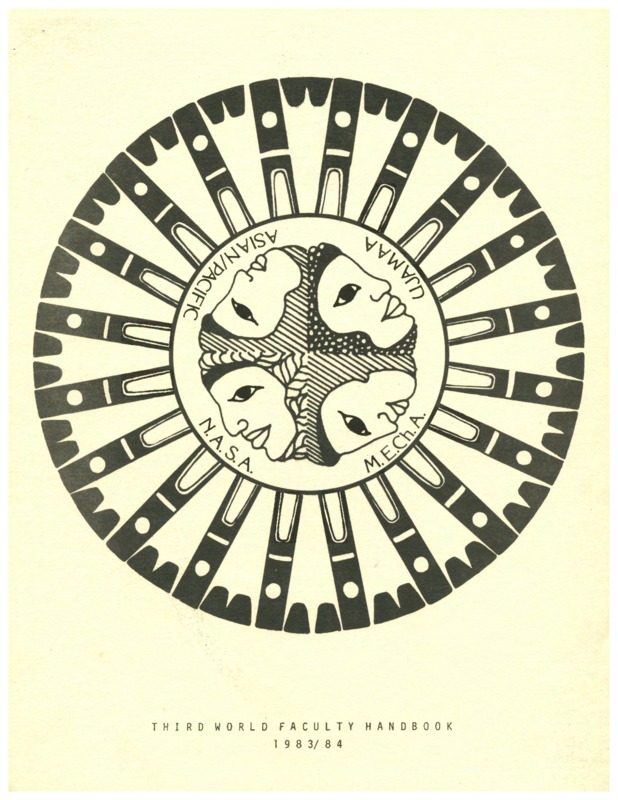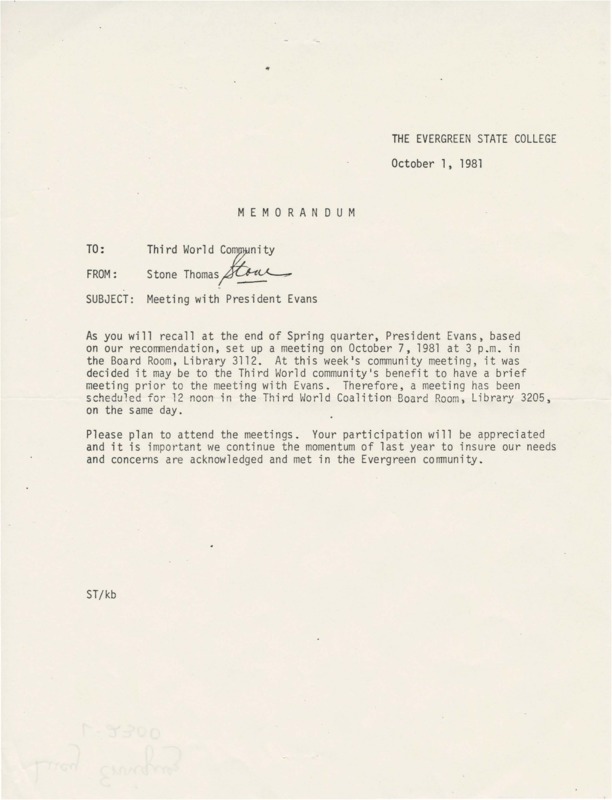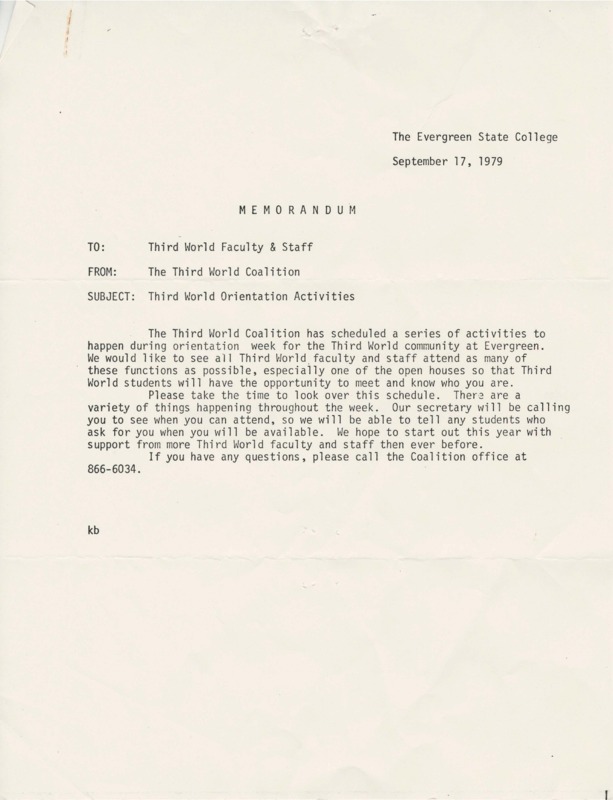Lesson Plan
Overview:
The First Peoples Multicultural, Trans and Queer Support Services began in 1972 with a group of students, faculty, and staff of color who realized that their conccerns and interests had been overlooked by the founders of The Evergreen State College. The group that formed called itself the Minority Coalition. Their efforts created the Non-White Coalition Office, whiched examined how the campus could be more responsive to the needs of its First Peoples community,
Three years later the Non-White Coalition Office changed its name to the Third World Coalition. In 1986, the name was changed again to the First Peoples Coalition in recognition of its members’ unique indigenous heritages. Members ranged from African America to Native American and Alaskan Natives, to Asian American, Pacific Islander, and Latinx.
The goal of the First Peoples Coalition was to be involved in all the different areas of campus in order to offer the best support to Evergreen’s students of color and it sought to provide a nucleus of social support for those students who were used to the greater cultural and ethnic diversity in their communities. The Coalition provided support, advocacy, referral, academic, and personal support for students and members of the Coalition worked hard on the recruitment and retention of students of color. Guidance and support often took the form of providing support for students who were falling behind in their classes or guidance on who to choose a faculty member, or guidance on how to write a contract. This support has, also, included a mentoring program where a student could request to match up with a staff or faculty member or alumni who would provide mentorship throughout the academic year. There was also a First Peoples library with periodicals and books that could be checked out by students.
The First Peoples Coalition also sponsored various kinds of workshops and talks with poets, activists, professors, and artists. They screened films, anything from the Tuskegee Experience to a film about the early Jewish immigrant experience in the US. Some of these were run by the First Peoples Peer Support and included topics on Financial Aid, Writing Self Evaluations, as well as Cultural Pursuit. Events celebrated by the First Peoples Coalition included Heritage Week (which included all cultures), Black History Month, Chinese New Year, Malcolm X Day, International Women’s Day, Asian Pacific Heritage Week, Indigenous Peoples Day, Kwanza, and many others depending on the year.
The First Peoples Coalition also evolved Evergreen’s Multicultural Scholars program, a program on campus for people of color and LGBTQ people. It was first offered in 1997 and introduced incoming students to Evergreen. The Coalition evolved into its current form, that of the First Peoples Multicultural, Trans and Queer Support Services which currently provides sponsored events and activities, including workshops, community forums, potlucks, and political discussions as well as peer and professional support, advising on academic, social, and personal avenues.
Discussion Questions:
-
Look at the Third World Coalition Handbook and compare with the First Peoples Catalogs from 1990 and 2006. How has the Coalition changed over time? What do you think is the cause of those changes and why? What sort of resources has the Coalition offered?
-
Compare the Third World Events, the Memo on Third World Activities, and the Workshop and Event Calendar for Day of Absence/Day of Presence 2014. What sort of activities has the First Peoples/Third World Coalition engaged in? What cultural groups are represented in these activities? Think about the themes revealed by the activities; what do the activities reveal about what the Coalition considered important?
-
Read through the Non-White Disappearing Task Force and Memos. What recommendations did the Task Force make? What can you infer about the environment of the early Evergreen campus was like for people of color?
-
Look at the Third World Community Information Sheet and the Memo from Stone Thomas to the Third World Community. In what ways were the Third World/First Peoples community involved in the early days? Who do you think were involved in the community?
-
Read through the Third World Faculty Handbook. What common themes do you see in the areas that faculty members teach? Are there areas that are missing? What could be some of the causes behind those missing areas?
Additional Resources:
https://evergreen.edu/news/post/campus-leaders-past-and-present-reflect-history-first-peoples-multicultural-advising
https://www.evergreen.edu/multicultural/
https://evergreen.edu/news/post/campus-leaders-past-and-present-reflect-history-first-peoples-multicultural-advising
https://www.evergreen.edu/multicultural/










